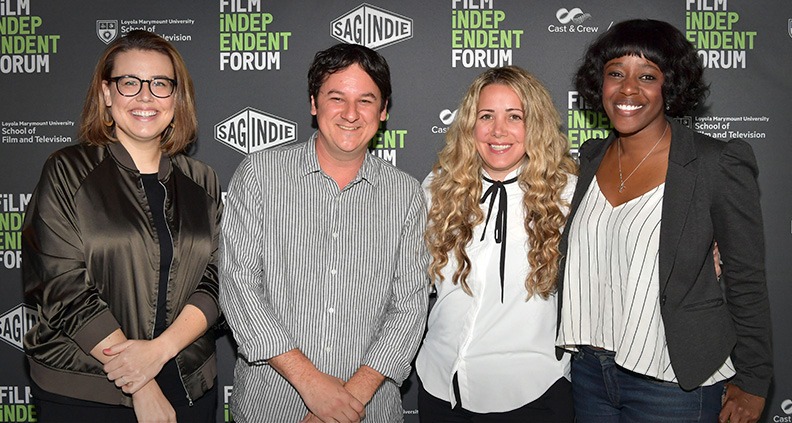In fact, creating content for brands—both large and small—can be artistically fulfilling as well as economically lucrative. It’s all about matching the right idea and aesthetic to the right product or company. And once the client is sold, all the usual tools of effective, cinematic visual storytelling come into play: sound design, cinematography, casting, shot selection, editing. Building your own brand was the subject of the Film Independent Forum panel “Your Logo Here” on April 27 at LMU’s new Playa Vista campus, part of #FiForum19. Moderated by Kristin Sauchak (VP, The Outcast Agency), the Saturday panel included branded content vets Danielle Hinde (Doomsday Entertainment), Folayo Lasaki (VP, Head of Marketing, SoulPancake) and producer Max Knies (City Beats with Santigold: Citizens Bank).
YOUR LOGO HERE: BRANDED ENTERTAINMENT
One story, multiple platforms. Asked how she approaches working with clients, SoulPancake’s Lasaki said: “For us it’s about finding out what the story is then making sure the platform it’s told on fits”—eg, making sure content is specifically tailored to each individual social outlet. “You can’t just create one thing and hope that it works everywhere,” she said. “We want to tell this one story with this one brand; on Facebook it looks this way, on YouTube it looks [another] way.” The key? Respecting both “the story we’re trying to tell” and the uniqueness of each platform. “We’re platform agnostic,” she said. Managing the brands. “It’s an important time to be honest with clients when you feel like [an idea] is not going to work,” said Knies. Said Sauchak, regarding the common outcry after a piece of branded content badly misses: “You don’t realize how many people are pushing a concept, and when that concept is on the train tracks, getting it off the tracks is nearly impossible.” In short: be smart enough to recognize a bad idea early, and bold enough to say so. Keeping your brand relevant. Like all industry paths, the world of branded entertainment can be an unforgiving one. “I always have to tell my directors, ‘You’re only as relevant as what you’ve made in the last six months.’” For filmmakers experiencing a dry spell, Hinde advises, “Just go out and shoot something,” even if only on an iPhone. Another option: find an unknown or up-and-coming musician to make a video for—you never know what will pop. Be uniquely yourself. “The one thing is: what is your style?” asked Hinde, who said she gets dismayed at the number director’s reels that are shot-for-shot projects her company had already done. “I don’t want another Hiro [Murai] after taxes,” she said. “I want someone with their own voice. Said Lasaki: “You don’t need to bulldoze your way into someone else’s lane. Create your own lane,” adding, “it does take a lot of hard work, and there’s no shortcut for that.” Adapt (and be excited by) new platforms. “Agencies are always looking for the new, now, next,” says Sauchak. “Right now it’s TikTok—what is it, what are kids doing on it—there’s always that ‘school of fish’ moment for platforms.” She added: “If you specifically want to work in branded content, pay attention to what platforms are emerging… If you’re able to think creatively within those new formats and have a point of view within that format, that puts you to the front of the line.” This includes framing shots natively for each platform and learning how to compose images and tell stories vertically. The industry is evolving. Knies explained: “The way it traditionally works is [ad agency creative directors and copywriters] write up an idea and sell the brand on it, then they go out and find a director.” These days, however, brands with means will develop filmmakers—as well as concepts—in house to help tell their stories. “So instead of selling a product, they’re selling a value or an idea of the product. They’re integrating a true story or something that’s more relatable to a general audience [with the product] in a more focused way.” Know what you bring to the table. “We have a lot of brands we work with repeatedly,” said Lasaki. “We have brands that come to us because they like our point of view. That’s really something that important, so have one; have a reason for people to choose you.” Said reason, apart from having a distinctive overall cinematic vision could be a specialty—a specific platform you’ve really drilled down and become and expert in, or a specific industry or business sector you cater to, like Sandwich Video’s work for tech start-ups. How to get discovered. Creativity, plus a unique point-of-view, plus the internet equals results. “Every day our creative directors, they follow 14,000 on Instagram. That’s where they’re finding new talent,” said Sauchak. “When we get a creative brief [from a potential client] they go ‘this person, this person, this person.’” Just remember: your first responsibility in all cases is to the audience—a strategy that will yield the best results for you and your client alike.
The 2019 Film Independent Forum took place April 26-28, 2019 at the new LMU Playa Vista campus in the heart of Silicon Beach—click here to see what else happened, and don’t forget to come back next year! The 2019 Film Independent Forum was supported by Premier Sponsors SAGindie, Cast & Crew and University Partner Loyola Marymount University School of Film and Television.
Get More Involved…
Twitter YouTube Instagram Membership
